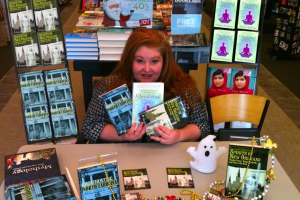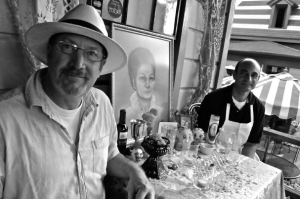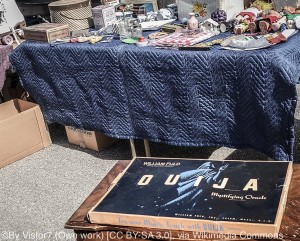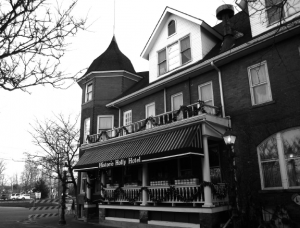The Cornstalk Hotel — A Story of Love and Ghosts
by Kala Ambrose
 The Cornstalk Hotel was originally built as a home in 1816 for Judge Francois Xavier-Martin, who is best known in Louisiana as a former chief justice for the Supreme Court. The home was designed according to his wishes, but records show that several homes had previously been built on this property, beginning in 1730. Each of the previous homes had been destroyed by fire, most likely by the two Great Fires of New Orleans—the first that destroyed 90% of the French Quarter and the second that destroyed more than 200 buildings. The records of who owned the homes before Judge Martin are missing (some were destroyed by fire), but it is assumed by most historians that several families lived at this location over the decades.
The Cornstalk Hotel was originally built as a home in 1816 for Judge Francois Xavier-Martin, who is best known in Louisiana as a former chief justice for the Supreme Court. The home was designed according to his wishes, but records show that several homes had previously been built on this property, beginning in 1730. Each of the previous homes had been destroyed by fire, most likely by the two Great Fires of New Orleans—the first that destroyed 90% of the French Quarter and the second that destroyed more than 200 buildings. The records of who owned the homes before Judge Martin are missing (some were destroyed by fire), but it is assumed by most historians that several families lived at this location over the decades.
A cast-iron fence resembling cornstalks
The tale of the haunted Cornstalk Hotel begins with a husband’s love for his wife. In 1834 Dr. Joseph Secondo Biamenti purchased the home for himself and his Iowa bride. He ordered a cast-iron fence to be installed around the property. In New Orleans, lovely homes with cast-iron balconies and fences are features found in great abundance on every corner of the city, so the chosen material on its own is not what has made the Cornstalk Hotel famous.
What causes this building to stand out in the French Quarter is that the cast-iron fence resembles cornstalks, as if one was looking out at a field of corn made completely from cast iron. Each column of the fence is anchored with a pumpkin. Climbing up each iron post are vines, leaves, and flowers, until you reach the top of the post, where cornstalks are partially open to display the kernels of corn inside.
The effect is whimsical, and the artisan must have worked long hours to shape iron into such delicate and intricate pieces, which include a butterfly landing on the front gate. The good doctor loved his wife dearly. Knowing that the swampy soil in New Orleans would never allow a field of corn to grow, he did the next best thing he could to bring an Iowa cornfield to his wife: He designed a unique fence that would remind her of home whenever she looked out the window.
Architecturally, the hotel is fascinating. It is listed in a multitude of travel guidebooks as a must-see location to photograph in the city. This hotel meets that list for other reasons, too, including the legends of ghosts haunting the building. Guests have reported hearing children laughing as their footsteps pitter-patter back and forth inside the house and outside.
There are also reports of hotel guests hearing the sounds of someone tapping on the window, only to find no one there when they pull back the curtain. They also report doors opening and closing in the middle of the night.
Cornstalk Hotel iron fence vibrates with energy
 At the hotel, I was psychically drawn to spend time outdoors rather than inside. The iron fence is quite captivating, and there is something almost electric about it. Iron was used in cemeteries, as it has a reputation of keeping spirits inside the area surrounded by iron or preventing them from entering an area surrounded by an iron fence, as ancient tales state that spirits are not able to cross over iron fences and gates.
At the hotel, I was psychically drawn to spend time outdoors rather than inside. The iron fence is quite captivating, and there is something almost electric about it. Iron was used in cemeteries, as it has a reputation of keeping spirits inside the area surrounded by iron or preventing them from entering an area surrounded by an iron fence, as ancient tales state that spirits are not able to cross over iron fences and gates.
This particular iron fence vibrated with an energy that I had not noticed elsewhere in the French Quarter. The fence emanated a blue hue, as if it was magnetized with an energy field. It had the look and feel of a spell, as if someone who knew what they were doing had magically placed a charm on the fence for purposes yet unknown.
As I tuned into the fence to determine what energy had been placed there, I followed the blue auric field and saw that it surrounded the property. Protective spells had been placed in this field to shield the hotel from any harm. The hotel certainly has a warm and welcoming feel about it. If you are standing in front of the fence from the street and want to see this blue energy field for yourself, you’ll find that the left side of the fence has the most energy, as if it wants to protect itself from energy coming from that direction. On the right side, the energy field is much more open and relaxed, appearing to not detect any harm coming from this side. This right side of the property is where the ghost boys are most often seen playing on the lawn.
As I continued to study the fence and the supernatural energy attached to it, I had the distinct feeling of being watched. I looked up at the hotel and saw a woman looking out at me from an upstairs window. I gave a friendly wave to her, thinking she was a guest, until I noticed that she was wearing a dark dress with a lace collar at the neck and had her hair pulled back into a tight bun. My first thought was that she was dressed in period clothing, perhaps for an event at the hotel. This thought soon vanished, however, for as I stood there looking at her, she disappeared into thin air, except for one of her hands, which remained there at the window for a few moments longer. She appeared to me as someone who was very protective and inquisitive about the comings and goings at the hotel.
 My encounter with the woman was very brief. She was quite a distance away, as I was outside near the fence looking up and she was upstairs inside the hotel, so there wasn’t a strong connection. The one thing I did feel strongly, however, was that she was not the wife of Dr. Biamenti. This woman appeared to be dressed more in the style of the late 1700s rather than the mid-1800s, when Dr. Biamenti and his wife lived in the home. Most likely she was an occupant of one of the previous homes that burned down.
My encounter with the woman was very brief. She was quite a distance away, as I was outside near the fence looking up and she was upstairs inside the hotel, so there wasn’t a strong connection. The one thing I did feel strongly, however, was that she was not the wife of Dr. Biamenti. This woman appeared to be dressed more in the style of the late 1700s rather than the mid-1800s, when Dr. Biamenti and his wife lived in the home. Most likely she was an occupant of one of the previous homes that burned down.
About the author: Kala Ambrose is an award-winning author, national columnist, inspirational speaker, and host of the Explore Your Spirit with Kala Radio and TV Show. Kala Ambrose’s teachings are described as discerning, empowering, and inspiring. For more haunted tales from New Orleans, check out her book Spirits of New Orleans: Voodoo Curses, Vampire Legends and Cities of the Dead.





